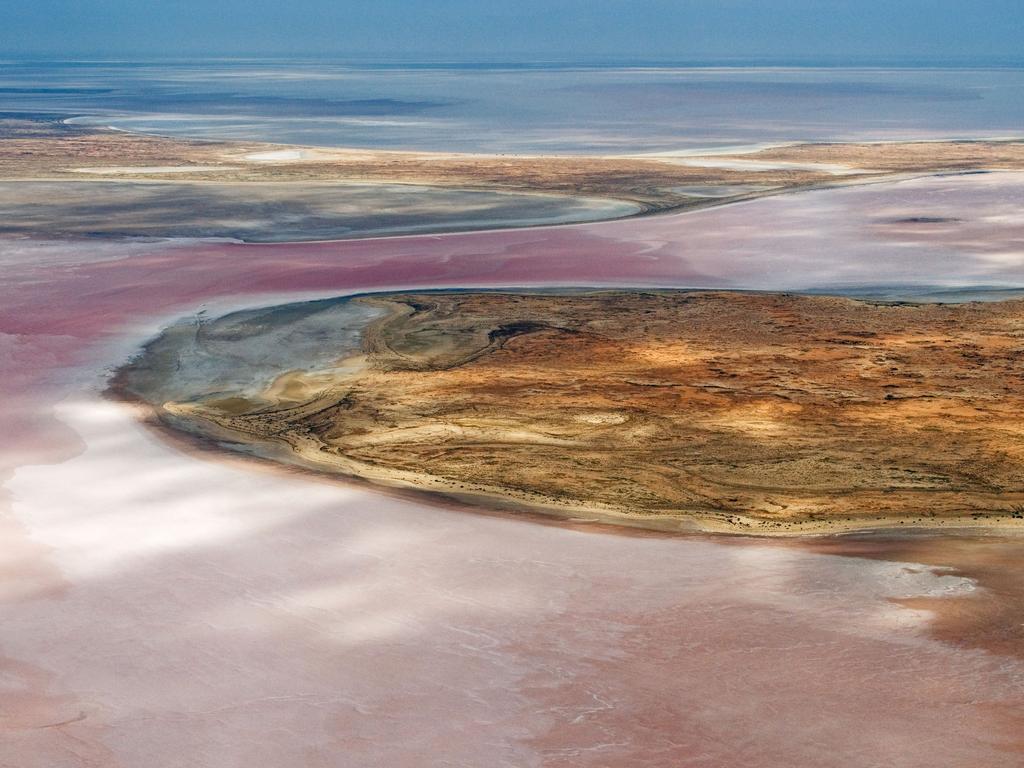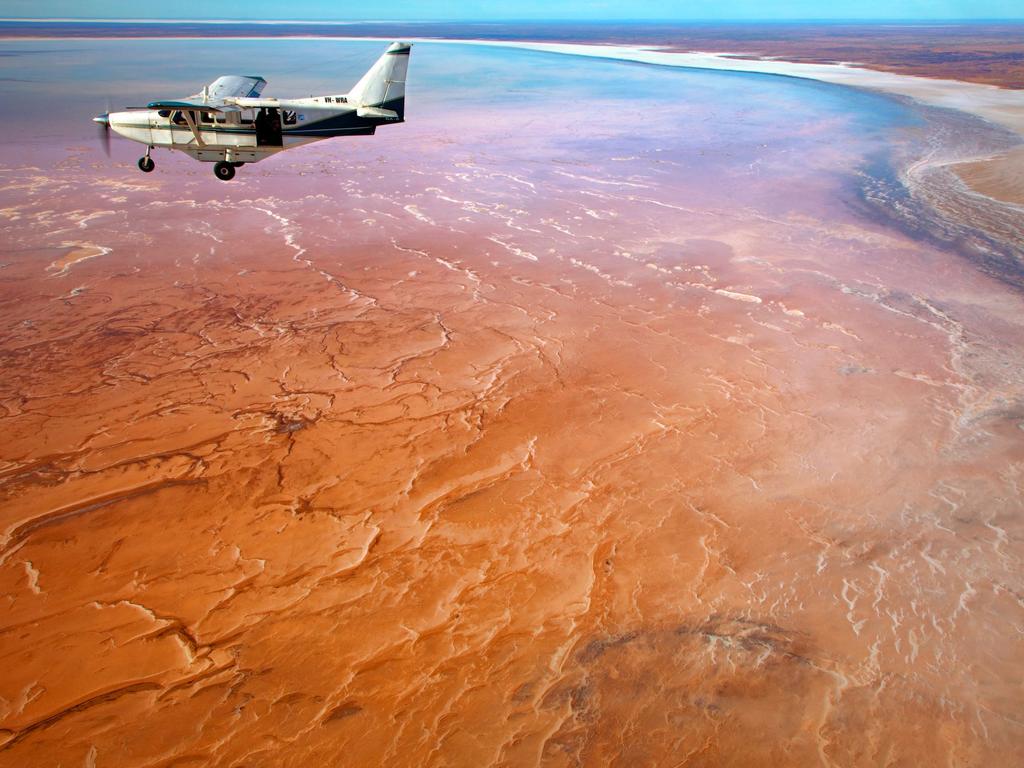‘Respect our culture’: Visitors to be banned from ‘sacred’ Lake Eyre under proposed plan
Visitors could soon be banned from one Australia’s most popular outback tourist destinations under a plan to protect the “sacred place” for its traditional owners.
Visitors could soon be banned from one of Australia’s most popular outback tourist destinations under a plan to protect the “sacred place” for its traditional owners.
Lake Eyre in South Australia, now known as Lake Eyre/Kati Thanda, is a 9500 square kilometre dry lake bed famous for infrequent and spectacular flooding.
On average, Lake Eyre experiences a small flood every three years, a large flood every decade, and fills only four times in 100 years – major events that see the network of creeks and lakes explode with life, attracting visitors from all over the world.
Sitting within the 1.3 million hectare Kati Thanda-Lake Eyre National Park in the state’s far north, the lake is a registered site under the Aboriginal Heritage Act 1988 and is co-managed by the state government and the Arabana Aboriginal Corporation.
A draft management plan, released for public consultation by the state government on Friday, would prevent any recreational access to the lake bed and would ban visitors from entering the lake bed on foot without permission.

“We are committed to genuine partnership with Arabana people through our co-management agreement,” said Jason Irving, director of National Parks Programs with the National Parks and Wildlife Service.
“The request for visitors not to enter a sacred cultural site is made in recognition and respect for Arabana culture, and to ensure the safety of visitors.”
Mr Irving said other recreational activities, including swimming, driving, boating and landing aircraft, were already restricted under the National Parks and Wildlife Act 1972.
“People are still encouraged to enjoy the park and view the spectacular lake bed from designated visitor areas or from the air,” Mr Irving said.
Bronwyn Dodd, chairwoman of the Arabana Aboriginal Corporation, said the lake was a very special place of cultural significance and great importance to Arabana people.
“We are proud to share this part of our Country but we urge you to respect our Ularaka [stories], lore and culture and not enter the lake,” Ms Dodd said.
“We have a responsibility to look after the lake and in turn it looks after us. Preservation of this lake is also the preservation of our culture.”

The Arabana people were formally recognised as the native title holders over land including Elliot Price Conservation Park and most of Kati Thanda-Lake Eyre National Park in 2012.
“Care for the welfare of visitors as they pass through Country is a responsibility that has been bestowed upon Arabana leaders by the Elders,” the draft plan states.
“Lake Eyre/Kati Thanda is a sacred place for Arabana people, and a central theme in Arabana dreaming. It is also known in Arabana law to be a highly dangerous place that should not be entered without appropriate cultural authority. For these reasons, recreational walking, swimming, driving and boating on Lake Eyre/Kati Thanda will not be permitted. Visitors will be encouraged to respect the wishes of Arabana people by viewing the lake from the designated visitor nodes, or from the air.”
Exceptions will be made for “essential management or emergency response activities”, while applications to access the lake for commercial filming and photography, scientific research and commercial tours “will be considered on a case-by-case basis”.
“A permit may be granted for activities that have been determined to be culturally appropriate by the Arabana Aboriginal Corporation,” the plan states.

“Due to the remoteness and size of Lake Eyre/Kati Thanda, ranger patrols will be combined with public education to achieve compliance with access restrictions. Education will focus on raising awareness of Arabana culture, promoting culturally appropriate ways to experience Lake Eyre/Kati Thanda, and sharing the reasoning behind these access restrictions.”
It also suggests that the “establishment of new tourism experiences that celebrate Arabana culture, such as guided tours, can create jobs for Arabana people, build respect for Arabana culture, and provide visitors with a more enriching experience”.
“The lake and lake bed in particular is of profound cultural significance to Arabana people and under Arabana lore must not be accessed without cultural authority,” it says.
“There are also many other culturally significant features and sites within these parks, many of which have not been surveyed or recorded. While many sites are protected by virtue of their remote location, they are susceptible to damage from visitors who may be unaware of their significance.”
Visitors to the park will be required to keep to designated camping areas, day visitor areas and vehicle tracks.

“This provides visitors with an enjoyable experience of the parks, while ensuring protection for the significant cultural values associated with the lake bed,” the plan states.
“This also ensures that the lake surface and fragile arid vegetation communities are not incrementally damaged through the movement of visitors, their vehicles and their equipment.”
Lake Eyre scenic flight operator Trevor Wright told The Advertiser on Sunday that the plan, if implemented, would have little impact as it would merely formalise what had been “unofficially in action for the last 10 to 20 years” for safety reasons.
He said the lake bed had a thin crust with crystallised gypsum “like broken panes of glass” underneath. “Seriously, if you walk on it and you’re in thongs or anything else, you’ll cut your skin to smithereens and you’ll sink down to your knees,” he said.
“It’s a commonsense approach of handling a really remote area tourist attraction, where people can still get the full value of it, enjoy it, and take heaps of photographs.”
The final plan is expected to be adopted later this year.
Several other cultural sites around the state, including Koonalda Caves in the Nullarbor Wilderness Protection Area, Sacred Canyon in Ikara-Flinders Ranges National Park, and Ngaut Ngaut Conservation Park, welcome visitors but have strict rules around entry.






